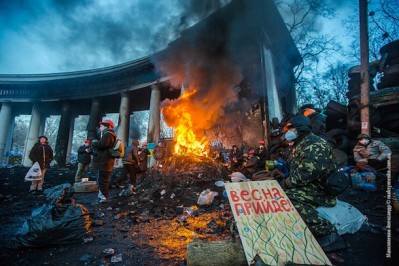KIEV, UKRAINE. Another stage of confrontations in the Ukraine is over. These days, the prolonged civil unrest, that is, anti-government demonstrations and mass protests that have become known as Euromaidan, maintaining a turbulent and chaotic situation in Ukraine, reached their peak, and probably, their culmination. As a result of failed attempts at political settlement and a lack of consensus, the political crisis and bloodshed during the manifestations obliged the ruling government to surrender the power. Yanukovych, the leader of the leading party and president suddenly disappeared. As a consequence, the Ukrainian Parliament could fill the power void in Ukraine, and as wished for by the protesters, after depriving Yanukovych from the presidential office, called for presidential elections that are to be held in late May 2014. Meanwhile, international experts debate about future changes of the political stage in the Ukraine. Nonetheless, to a large extent these experts agree that this is an excellent opportunity for pro-European and pro-Western forces to gain power.
To some, this may seem the political end of Yanukovych and the domination of the party from the East, as the Party of Regions is also called. This is not all too clear, however. It is important to note that Yanukovych has experienced a similar situation previously in 2005, when due to the pressure caused by the Orange revolution he had to step down during the presidential elections. This time around, regardless of who may come to sit in the presidential or PM office, -whether former PM Yulia Tymoshenko who was recently released from the prison or WBC super heavyweight champion Vitali Klitschko, or any other candidate,- it seems doubtful that the political crisis will wither away. The future president of Ukraine, PM and the Parliament will face challenges such as the state’s bankruptcy, outrageous level of corruption and poverty of the majority of the population. It is still a long way before the political direction of the Ukraine may become clearly defined.
Various reasons can be given to explain why protesters went out on the streets of Kiev. Simply said, the current crisis seems the effect caused by the fact that Yanukovych did not sign the association agreement with the European Union (EU) and preferring Russia’s loan instead, an act that was regarded as hijacking of Ukrainian European dream. Pro-Western opposition groups and their followers considered Ukraine’s association with the EU as first step towards further EU integration.
Another reason is the dissatisfaction of the population with the governance of Yanukovych, who did not fulfill his electoral promises, while the socio-economic situation deteriorated drastically. One can further point to corruption scandals and simultaneous games of Yanukovych with both the EU on one side and Russia on the other.
However, an all-encompassing explanation for the current state of affairs in Ukraine is the explosion of discontent about the deferred solutions to numerous rooted social problems, which have existed since the appearance of the Ukraine on the world map. Addressing these needs requires many reforms, not populism as has been the answer of previous governments.
The future president and his government will have to face the challenge of Ukrainian national unity, which is complicated by the existence of a strong regional mentality both in the west of the Ukraine westwards and in the east eastwards, keeping the country divided. Thus, cultural, linguistic and economic differences characterize both parts of the Ukraine, which have formed distinct identities: the West tending towards European identity and the East tending towards Russia.
The Party of Regions of Ukraine has its electoral base in the East and therefore, Russia is represented as a big brother, the most important economic partner and the only source and guarantor of the country’s economic survival. The electoral base of most of pro-EU integration parties is located in the West of Ukraine. Western Ukraine regards the EU as the only political path for the Ukraine to maintain independence and to foster and share European values.
Considering the antagonized positions of both parts regarding the national future, an end to the confrontation on the streets, does not automatically end the confrontation on the political stage. It seems a complicated task to start unifying the identities of both parts of Ukraine. Among the known candidates for the presidential and PM positions it is not clear who could receive support from both parts.
These are the challenges ahead for the Ukraine.

